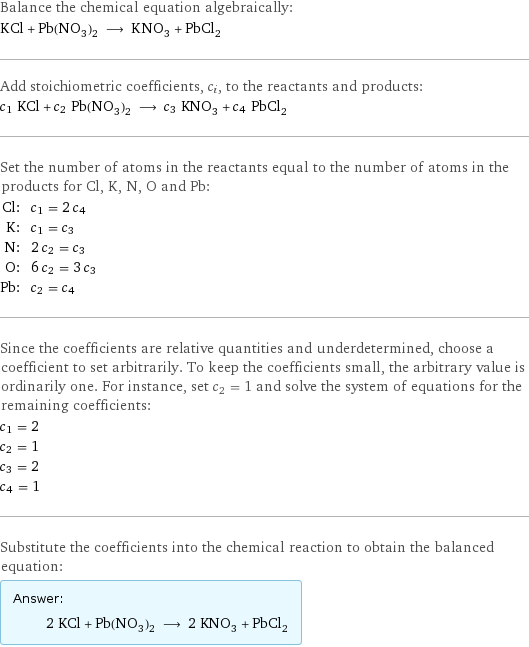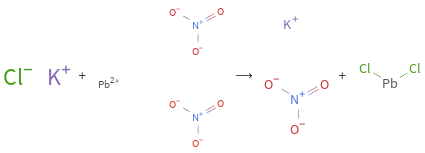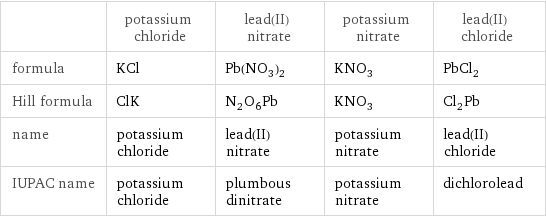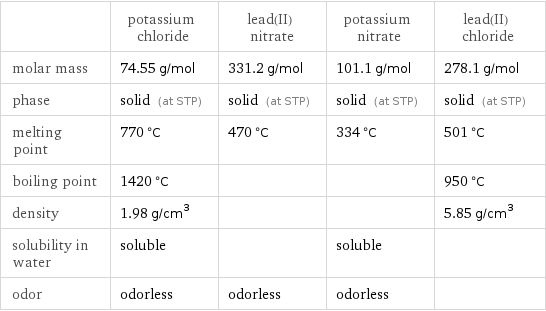Input interpretation

KCl potassium chloride + Pb(NO_3)_2 lead(II) nitrate ⟶ KNO_3 potassium nitrate + PbCl_2 lead(II) chloride
Balanced equation

Balance the chemical equation algebraically: KCl + Pb(NO_3)_2 ⟶ KNO_3 + PbCl_2 Add stoichiometric coefficients, c_i, to the reactants and products: c_1 KCl + c_2 Pb(NO_3)_2 ⟶ c_3 KNO_3 + c_4 PbCl_2 Set the number of atoms in the reactants equal to the number of atoms in the products for Cl, K, N, O and Pb: Cl: | c_1 = 2 c_4 K: | c_1 = c_3 N: | 2 c_2 = c_3 O: | 6 c_2 = 3 c_3 Pb: | c_2 = c_4 Since the coefficients are relative quantities and underdetermined, choose a coefficient to set arbitrarily. To keep the coefficients small, the arbitrary value is ordinarily one. For instance, set c_2 = 1 and solve the system of equations for the remaining coefficients: c_1 = 2 c_2 = 1 c_3 = 2 c_4 = 1 Substitute the coefficients into the chemical reaction to obtain the balanced equation: Answer: | | 2 KCl + Pb(NO_3)_2 ⟶ 2 KNO_3 + PbCl_2
Structures

+ ⟶ +
Names

potassium chloride + lead(II) nitrate ⟶ potassium nitrate + lead(II) chloride
Reaction thermodynamics
Enthalpy

| potassium chloride | lead(II) nitrate | potassium nitrate | lead(II) chloride molecular enthalpy | -436.5 kJ/mol | -451.9 kJ/mol | -494.6 kJ/mol | -359.4 kJ/mol total enthalpy | -873 kJ/mol | -451.9 kJ/mol | -989.2 kJ/mol | -359.4 kJ/mol | H_initial = -1325 kJ/mol | | H_final = -1349 kJ/mol | ΔH_rxn^0 | -1349 kJ/mol - -1325 kJ/mol = -23.7 kJ/mol (exothermic) | | |
Equilibrium constant
![Construct the equilibrium constant, K, expression for: KCl + Pb(NO_3)_2 ⟶ KNO_3 + PbCl_2 Plan: • Balance the chemical equation. • Determine the stoichiometric numbers. • Assemble the activity expression for each chemical species. • Use the activity expressions to build the equilibrium constant expression. Write the balanced chemical equation: 2 KCl + Pb(NO_3)_2 ⟶ 2 KNO_3 + PbCl_2 Assign stoichiometric numbers, ν_i, using the stoichiometric coefficients, c_i, from the balanced chemical equation in the following manner: ν_i = -c_i for reactants and ν_i = c_i for products: chemical species | c_i | ν_i KCl | 2 | -2 Pb(NO_3)_2 | 1 | -1 KNO_3 | 2 | 2 PbCl_2 | 1 | 1 Assemble the activity expressions accounting for the state of matter and ν_i: chemical species | c_i | ν_i | activity expression KCl | 2 | -2 | ([KCl])^(-2) Pb(NO_3)_2 | 1 | -1 | ([Pb(NO3)2])^(-1) KNO_3 | 2 | 2 | ([KNO3])^2 PbCl_2 | 1 | 1 | [PbCl2] The equilibrium constant symbol in the concentration basis is: K_c Mulitply the activity expressions to arrive at the K_c expression: Answer: | | K_c = ([KCl])^(-2) ([Pb(NO3)2])^(-1) ([KNO3])^2 [PbCl2] = (([KNO3])^2 [PbCl2])/(([KCl])^2 [Pb(NO3)2])](../image_source/1f5df0c44511ac9d92584298fefadb3f.png)
Construct the equilibrium constant, K, expression for: KCl + Pb(NO_3)_2 ⟶ KNO_3 + PbCl_2 Plan: • Balance the chemical equation. • Determine the stoichiometric numbers. • Assemble the activity expression for each chemical species. • Use the activity expressions to build the equilibrium constant expression. Write the balanced chemical equation: 2 KCl + Pb(NO_3)_2 ⟶ 2 KNO_3 + PbCl_2 Assign stoichiometric numbers, ν_i, using the stoichiometric coefficients, c_i, from the balanced chemical equation in the following manner: ν_i = -c_i for reactants and ν_i = c_i for products: chemical species | c_i | ν_i KCl | 2 | -2 Pb(NO_3)_2 | 1 | -1 KNO_3 | 2 | 2 PbCl_2 | 1 | 1 Assemble the activity expressions accounting for the state of matter and ν_i: chemical species | c_i | ν_i | activity expression KCl | 2 | -2 | ([KCl])^(-2) Pb(NO_3)_2 | 1 | -1 | ([Pb(NO3)2])^(-1) KNO_3 | 2 | 2 | ([KNO3])^2 PbCl_2 | 1 | 1 | [PbCl2] The equilibrium constant symbol in the concentration basis is: K_c Mulitply the activity expressions to arrive at the K_c expression: Answer: | | K_c = ([KCl])^(-2) ([Pb(NO3)2])^(-1) ([KNO3])^2 [PbCl2] = (([KNO3])^2 [PbCl2])/(([KCl])^2 [Pb(NO3)2])
Rate of reaction
![Construct the rate of reaction expression for: KCl + Pb(NO_3)_2 ⟶ KNO_3 + PbCl_2 Plan: • Balance the chemical equation. • Determine the stoichiometric numbers. • Assemble the rate term for each chemical species. • Write the rate of reaction expression. Write the balanced chemical equation: 2 KCl + Pb(NO_3)_2 ⟶ 2 KNO_3 + PbCl_2 Assign stoichiometric numbers, ν_i, using the stoichiometric coefficients, c_i, from the balanced chemical equation in the following manner: ν_i = -c_i for reactants and ν_i = c_i for products: chemical species | c_i | ν_i KCl | 2 | -2 Pb(NO_3)_2 | 1 | -1 KNO_3 | 2 | 2 PbCl_2 | 1 | 1 The rate term for each chemical species, B_i, is 1/ν_i(Δ[B_i])/(Δt) where [B_i] is the amount concentration and t is time: chemical species | c_i | ν_i | rate term KCl | 2 | -2 | -1/2 (Δ[KCl])/(Δt) Pb(NO_3)_2 | 1 | -1 | -(Δ[Pb(NO3)2])/(Δt) KNO_3 | 2 | 2 | 1/2 (Δ[KNO3])/(Δt) PbCl_2 | 1 | 1 | (Δ[PbCl2])/(Δt) (for infinitesimal rate of change, replace Δ with d) Set the rate terms equal to each other to arrive at the rate expression: Answer: | | rate = -1/2 (Δ[KCl])/(Δt) = -(Δ[Pb(NO3)2])/(Δt) = 1/2 (Δ[KNO3])/(Δt) = (Δ[PbCl2])/(Δt) (assuming constant volume and no accumulation of intermediates or side products)](../image_source/089bcada1e36f1040220e2058962eaeb.png)
Construct the rate of reaction expression for: KCl + Pb(NO_3)_2 ⟶ KNO_3 + PbCl_2 Plan: • Balance the chemical equation. • Determine the stoichiometric numbers. • Assemble the rate term for each chemical species. • Write the rate of reaction expression. Write the balanced chemical equation: 2 KCl + Pb(NO_3)_2 ⟶ 2 KNO_3 + PbCl_2 Assign stoichiometric numbers, ν_i, using the stoichiometric coefficients, c_i, from the balanced chemical equation in the following manner: ν_i = -c_i for reactants and ν_i = c_i for products: chemical species | c_i | ν_i KCl | 2 | -2 Pb(NO_3)_2 | 1 | -1 KNO_3 | 2 | 2 PbCl_2 | 1 | 1 The rate term for each chemical species, B_i, is 1/ν_i(Δ[B_i])/(Δt) where [B_i] is the amount concentration and t is time: chemical species | c_i | ν_i | rate term KCl | 2 | -2 | -1/2 (Δ[KCl])/(Δt) Pb(NO_3)_2 | 1 | -1 | -(Δ[Pb(NO3)2])/(Δt) KNO_3 | 2 | 2 | 1/2 (Δ[KNO3])/(Δt) PbCl_2 | 1 | 1 | (Δ[PbCl2])/(Δt) (for infinitesimal rate of change, replace Δ with d) Set the rate terms equal to each other to arrive at the rate expression: Answer: | | rate = -1/2 (Δ[KCl])/(Δt) = -(Δ[Pb(NO3)2])/(Δt) = 1/2 (Δ[KNO3])/(Δt) = (Δ[PbCl2])/(Δt) (assuming constant volume and no accumulation of intermediates or side products)
Chemical names and formulas

| potassium chloride | lead(II) nitrate | potassium nitrate | lead(II) chloride formula | KCl | Pb(NO_3)_2 | KNO_3 | PbCl_2 Hill formula | ClK | N_2O_6Pb | KNO_3 | Cl_2Pb name | potassium chloride | lead(II) nitrate | potassium nitrate | lead(II) chloride IUPAC name | potassium chloride | plumbous dinitrate | potassium nitrate | dichlorolead
Substance properties

| potassium chloride | lead(II) nitrate | potassium nitrate | lead(II) chloride molar mass | 74.55 g/mol | 331.2 g/mol | 101.1 g/mol | 278.1 g/mol phase | solid (at STP) | solid (at STP) | solid (at STP) | solid (at STP) melting point | 770 °C | 470 °C | 334 °C | 501 °C boiling point | 1420 °C | | | 950 °C density | 1.98 g/cm^3 | | | 5.85 g/cm^3 solubility in water | soluble | | soluble | odor | odorless | odorless | odorless |
Units
